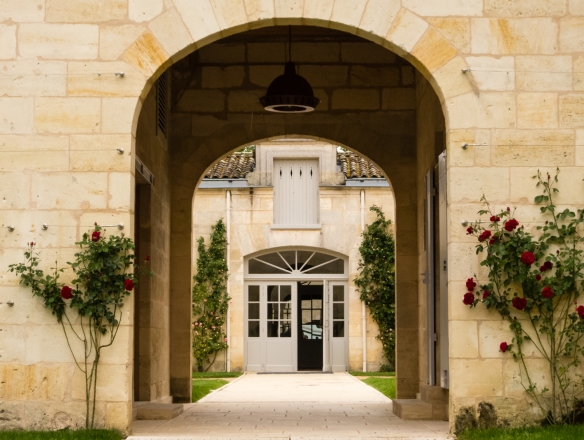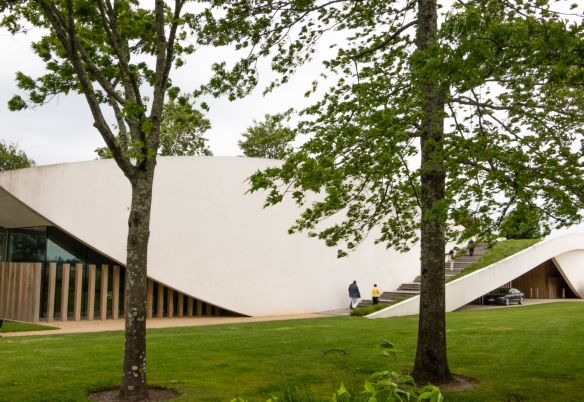
Le Cheval Blanc (the white horse) is the symbol of the premier wine producing estate Château Cheval Blanc, Saint-Émilion, Bordeaux region, France
Château Cheval Blanc (White Horse Castle) is one of only four estates whose wines are rated at the highest level, Premier Grand Cru Classé A in Saint-Émilion in the Bordeaux wine region of France. Archives show that vines have been grown at Cheval Blanc at least as far back as the 15th century.

The historic Château Cheval Blanc (White Horse Castle), Saint-Émilion, Bordeaux region, France
“In 1832, Château Figeac sold 15 hectares/37 acres to M. Laussac-Fourcaud, including part of the narrow gravel ridge that runs through Figeac and neighboring vineyards and reaches Château Petrus just over the border in Pomerol. This became Château Cheval Blanc which, in the International London and Paris Exhibitiohns in 1862 and 1867, won medals still prominent on its labels. The château remained in the family until 1998, when it was sold to Bernaud Arnault, chairman of luxury goods group LVMH, and Belgian businessman Albert Frère.” — Wikipedia

Entrance to Château Cheval Blanc (White Horse Castle) whose wines are rated at the highest level, Premier Grand Cru Classé A in Saint-Émilion in the Bordeaux wine region of France

Vineyards of Château Cheval Blanc, Saint-Émilion, Bordeaux region, France, overlooking a neighboring Château
“What makes Cheval Blanc so unusual is three main soil types – fine textured with clay, more coarsely textured with gravel, and large gravel with sand – that constitute a veritable patchwork. This singular terroir is made up primarily of clay and large-size gravel in certain plots and sandy soil with smaller gravel in other parts. Some estates in Saint-Emilion have excellent gravelly soil, while others in Saint-Emilion and Pomerol have very good clay soils. Cheval Blanc, on the other hand, is blessed with both types of soil in fairly equal proportions.” – http://www.chateau-cheval-blanc.com

The impressive new cellar at Château Cheval Blanc, Saint-Émilion, Bordeaux region, France that opened in 2011
An “impressive new cellar [was built] adjacent to the château. Designed by Christian de Portzamparc, winner of the 1994 Pritzker Architecture Prize in 1994, this was completed in June 2011. Reflecting the desire of Baron Albert Frère and Bernard Arnault, this building is both futuristic and in keeping with the surrounding historic vineyard landscape listed as a World Heritage Site by UNESCO.” — http://www.chateau-cheval-blanc.com

New concrete tanks for fermentation and blending in the new 2011 cellar at Château Cheval Blanc, Saint-Émilion, Bordeaux region, France

The exterior of the new cellar, showing part of the “infinity loop” design, Château Cheval Blanc, Saint-Émilion, Bordeaux region, France

Our tasting for the morning was a magnificent 2011 Château Cheval Blanc at the winery in Saint-Émilion, Bordeaux region, France
“TASTING NOTES: This elegant, delicate wine is slated to be a great classic. The colour is deep red and the nose is complex from the very first, expressing a floral (violet and peony) aspect that gives way to attractive red fruit, raspberry, and black cherry aromas. This vintage shines thanks to its aromatic freshness and precision. It starts off very full-bodied on the palate. The middle palate is quite full, rich, and voluptuous, and the aftertaste is interminable. The tannin is smooth, silky, and elegant, and the wine is altogether perfectly balanced, with lovely fresh fruit on the finish.” — http://www.chateau-cheval-blanc.com

The chapel and side view of the historic Château at Château Cheval Blanc, Saint-Émilion, Bordeaux region, France

Rich, Thanks. We missed Cheval Blanc in our tour of Bordeaux wineries last week but took many pictures similar to yours. Those old wineries and their chateaux have a look about them. Unfortunately, my I-phone with all the pictures was lost when I left it on the train from Bordeaux to Paris. –Paul
LikeLiked by 1 person
Tell Shirley that it was terrific to literally “bump” into you both outside the Grand Hotel in Bordeaux! Good to hear that you, too, had great experiences, but sad 😦 to hear that your forgot your phone on the train. So enjoy these posts of Bordeaux and hopefully they bring back some great memories.
LikeLike
Do you think they had irrigation back in the 15th century or did they have to water each vine by hand? If those 15th century folks could only see the new, pristine chateau now.
LikeLiked by 1 person
According to Wikipedia: “In many Old World wine regions, natural rainfall is considered the only source for water that will still allow the vineyard to maintain its terroir characteristics. The practice of irrigation is viewed by some critics as unduly manipulative with the potential for detrimental wine quality due to high yields that can be artificially increased with irrigation. It has been historically banned by the European Union’s wine laws, though in recent years individual countries (such as Spain) have been loosening their regulations and France’s wine governing body, the Institut National des Appellations d’Origine (INAO), has also been reviewing the issue.”
Wine writer and authority Jancis Robinson on April 7, 2007 wrote in a post, “Quietly, irrigation has now officially been legalised in France. A decree dated December 6 and published at the end of February permits irrigation from June 15 up to the French national holiday of August 15, although for AC vineyards it is allowed only if sanctioned by the individual appellation authorities. Until quite recently the French officially viewed rainfall as a boon but irrigation as a wicked New World ploy and a potentially dangerous way of boosting the volume of wine produced. Global warming seems to have changed this view. Curiously, permanent irrigation systems such as the particularly efficient and ecologically sound drip irrigation are specifically outlawed.
LikeLike